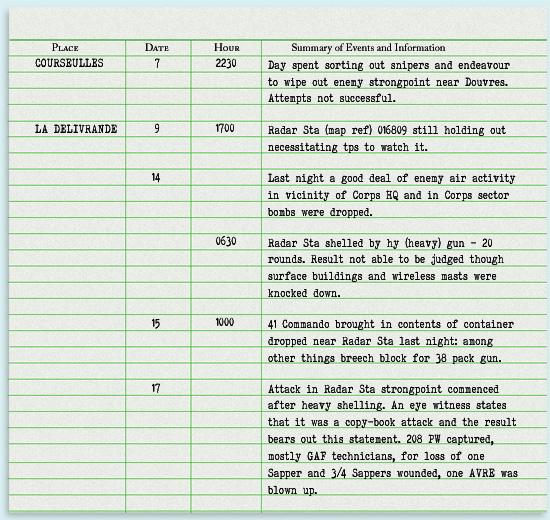|
15 June 1944 At 08.00 hours, Hpt. Wilhelm of IX. Fliegerkorps reported that so far there had been two supply operations (apparently to Douvres) each involving three Ju 88s. These missions had been flown at night because of the air situation but even then only one Ju 88 reached the target each time. The strongpoint was 800 x 1000 metres and the drop point was marked by three fires arranged in a triangle. The lesson drawn from these attempts was that small strongpoints were difficult to find and if the signals were laid out wrongly there was a danger that the canisters would fall outside the defended area, even when dropped from low altitude. The British I Corps had established its HQ at La Délivrande, a few hundred metres from Distelfink, on D+2 and commented on developments in its daily intelligence summaries:
The III./SG 4's War Diary notes that Obstltn. Alfred Druschel, then an inspector on the staff of the General der Schlachtflieger, visited III./SG 4 at Laval on the 15th. The same day, an Fw 190 A-6 of the Gruppe, W.Nr. 530126 (DQ+RZ) was received by the AGO repair works at Cravant. At 17.30 hours, the Operations Officer of the Airfield Command for the Laval Region was advised that III./SG 4 intended to occupy the alternative landing ground at Rochefort (25 miles east northeast of Chartres) but that the construction of an approach road was required. At the same time, III./SG 4 (along with JG 1, 2, 3, 26 and 27) was ordered to be at three minutes' readiness from first light on the 16th. Their task was to screen attacks by ground troops between Troarn and the mouth of the River Orne. The first of four missions was to be over the target at 05.45 hours local time and III./SG 4 was to put in a maximum effort against troop concentrations just west of the Bénouville bridge. 16 June 1944 From Douvres, 8./LN Regt. 53 signalled that a sally to reach the fourth supply canister had failed. The inference is that three others were retrieved but the defenders still called for Panzerfäuste, sticky bombs, MG 34 machine guns and ammunition belts, machine pistol magazines, a medical kit, a toolkit and signal flares. 17 June 1944 At 21.00 hours GMT the Flivo of I. SS Panzer Korps reported a "special operation" to supply Douvres but the position had surrendered earlier in the day after an assault by British armour and Royal Marine Commandos. Three days afterward, Luftflotte 3 requested a mention in the Wehrmacht dispatch of “a Luftwaffe signals detachment under the leadership of Oblt. Eckle [sic] which has held out in a strongpoint (Distelfink) against a superior enemy from the start of the invasion until 17 June. Their last wireless message read: ‘Many tanks breaking into our position!’” When in October the General of Signals described examples outstanding service by his troops, he had this to say of Distelfink, which: ‘… from 6 June was in heavy fighting against airborne troops, infantry and armour. The position held out until 17 June … on 26 June the strongpoint and its CO, Oblt. [Kurt] Egle were cited in the Wehrmacht communiqué. Since then Oblt. Egle has been awarded the Knight’s Cross of the Iron Cross.” (The announcement was broadcast on German radio on 6 July).
18 June 1944 The II. Fliegerkorps that morning announced that 12 of III./SG 4's Fw 190s would take off right away for Clermont-Ferrand in Central France, far from the battle front, and await the rest of the unit there. In all, five missions would be flown against French Resistance fighters by the month's end. 21 June 1944 The airfield command at Clermont-Ferrand, reported to Orléans that demand from SG 4 for bombs was very small and could be met from existing stocks. For its part, Feldluftgau Westfrankreich in Tours was asking Orléans how many and what type of "supply bombs" had been used in supplying Distelfink. 23 June 1944 According to the War Diary III./SG 4 exchanged its Fw 190 A-6s for F-8 models on this date. At this period Clermont-Ferrand seems to have dealt with the repair and delivery of Fw 190s to SG 103 as well. 24 June 1944 The rearguard of III./SG 4 was told (a) to dispatch a detachment with lorries and personnel to the airfield at Dreux for Oblt. Kellmer; and (b) to have the workshop get the aircraft there ready to be ferried to Clermont-Ferrand. A separate order sent Ju 52 A7+CK to collect ignition batteries for III./SG 4 from a depot at Valence. 26 June 1944 The airfield command at Avord reported the arrival of 9./SG 4 from Clermont-Ferrand with 11 aircraft, two officers and nine men. continued on next page …
|
|||||
PART SEVEN OF NINE |
|||||


